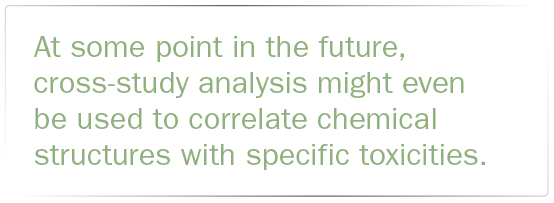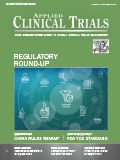Unleashing New Insights from Toxicology Studies
Applied Clinical Trials
The long-running SEND initiative has fostered new FDA-industry partnerships, opening the door to dramatic changes in toxicology data analysis.

Just under a third of the cost to develop an FDA-approved drug is attributable to pre-human laboratory research, reports have found. For decades, FDA and the pharmaceutical industry have agreed that streamlining and optimizing preclinical drug development-which typically includes laboratory toxicology studies-would not only save money but also prevent patient harm by identifying non-viable candidates before they ever enter human trials.
One of the best ways to streamline pre-human toxicology studies and, therefore, reduce attrition in drug development is to leverage the power of big data-combining thousands of prior toxicology studies into a searchable database that can be used to glean insights and search for potential links among similar drugs.
But because all these pre-human studies are conducted in different formats by different companies using different terminology, the promise of cross-study analysis has not been realized-until now.
Today, the industry is on the cusp of a revolution in the way toxicology studies are cataloged, analyzed, and leveraged, experts agree. And it’s all because of a pilot project that was first launched by the FDA back in 2002 called the Standard for Exchange of Nonclinical Data (SEND) initiative.
For nearly a decade, SEND chugged along under the stewardship of the Clinical Data Interchange Standards Consortium (CDISC), eventually resulting in a data standard that is widely used today. That standard, in turn, fostered new FDA partnerships with groups like BioCelerate, an organization of pharmaceutical companies dedicated to identifying efficiencies in nonclinical research, and the Pharmaceutical Users Software Exchange (PhUSE), a non-profit consortium of data managers, biostatisticians, data scientists, and eClinical IT professionals.
In 2014, FDA officially mandated that any pharma or biotech company submitting an investigational new drug (IND) application would need to start complying with SEND. The first SEND-compliant toxicology studies started rolling out in 2016, the year of the deadline. Now, as those studies start to accumulate, the industry is waking up to the fact that it may be on the cusp of a dramatic change in the status quo of toxicology data analysis.
“The earlier you can either adjust a compound to avoid toxicity or stop development on a compound that’s fatally flawed, the more resources a company has to go to other compounds and get more useful drugs on the market,” says William Houser, senior research scientist for Bristol-Myers Squibb, a member of BioCelerate.
“Usually, preclinical studies are not very large. However, these studies must provide detailed information on dosing and toxicity levels,” says Lilliam Rosario, PhD, director, Office of Computational Science at FDA’s Center for Drug Evaluation and Research (CDER). “After preclinical testing, researchers review their findings and decide whether the drug should be tested in people. For the pharmaceutical industry, it becomes particularly more expensive in the later stages of clinical development.”
Today, many believe that the holy grail of the SEND initiative will be to enable cross-study analysis, improving the industry’s ability to weed out dud candidates, explains Houser.
“The SEND standard has been out for a number of years, so why is it that only now people are beginning to do this?” asks Houser. “It’s due to the speed of the pipeline. SEND began for studies in 2016. So now we are three years after that, [meaning] we are just now approaching a critical mass of studies created across the industry that would enable this.”
“The exciting thing for me is that just not too long ago, I used to measure a submission to FDA on how many boxes went out on a truck,” says Lou Ann Kramer, CDISC’s senior director of standards development. “We paid a lot just to exchange data.”
But thanks in part to the SEND initiative, there is a new atmosphere of collaboration around preclinical toxicity data among pharmaceutical companies.
“I don’t think we’ve realized how revolutionary this all is,” says Kramer. “Someday we’re going to look back on this data standard being used as a major turning point in research.”
Benefits of cross-study analysis
At a very basic level, cross-study analysis is the ability to pull studies quickly and compare them on a computer screen, ideally using some sort of visualization tool to understand patterns, explains Todd Page, director of toxicology, Eli Lilly and Company, also a member of BioCelerate.

This type of analysis would allow scientists to better understand off-target versus on-target effects, and to isolate the effects of “vehicles,” or the inert substances used to deliver a drug that can also sometimes cause toxicity. At some point in the future, cross-study analysis might even be used to correlate chemical structures with specific toxicities, says Page.
“We’re now beginning to have studies that can be used for cross- study analysis,” says Houser. “It’s approaching 1,000 studies that have been received by the FDA.”
“I think it’s in its infancy,” adds Kramer, but soon “we are going to get to the point where we get enough data where we’ll start to see things. We never had that line of sight before.”
FDA collaborations
FDA’s long-standing partnership with CDISC was a natural result of the SEND collaboration, which CDISC took ownership of shortly after it was ideated at FDA, explains Kramer. In the subsequent years, as the SEND data standards were finalized, FDA also forged additional partnerships to maximize the standard’s reach.
“FDAs collaboration with BioCelerate is to evaluate and disseminate findings related to the use of [SEND] that can contribute to a more effective analysis of nonclinical studies conducted in support of product development and regulatory applications,” says Rosario.
“We anticipate that this collaboration will facilitate the discussion and information-sharing among FDA and industry to support shared aims of more efficient, effective, and data-driven decision-making in nonclinical research.”
According to Page, the BioCelerate consortium got started on its own standard before it began collaborating with FDA.
“The FDA collaboration helped things take off because they have a rich data set, but also because they are as dedicated to solving this as we are,” says Page. “Our interests are very much aligned. They want to be able to look across studies just as much as we in industry do. They want to ensure patient safety just as much as we do.”
According to Rosario, FDA has also partnered with PhUSE to co-sponsor the FDA/PhUSE Computational Science Symposium, during which participants will share best practices around data standards, analytical tool development, and business processes that are driving the development of IT systems.
“This annual meeting brings together FDA, industry, and academia to work together in a non-competitive environment to find solutions to shared problems and challenges,” she says.
Ongoing challenges
The SEND standard didn’t solve data harmonization problems overnight. Today, stakeholders are still working out how to best collect and present data for cross-study analysis.
“When the data standard was designed, it was designed with the intent of looking at one study in isolation,” says Page. The standard allowed a bit more flexibility for industry sponsors, he notes, but ultimately “that’s not a good thing for cross-study analysis.”
There are subtle differences in the way information is inputted, down to mundane details like which abbreviation a laboratory might use for various measurements.
FDA and BioCelerate are collaborating on a new harmonization initiative aimed at ironing out the existing kinks in the SEND standard.
In November, the two parties published a joint manuscript in the journal Regulatory Toxicology and Pharmacology, which identifies common variability in certain SEND domains and describes how variability can be managed to enable cross-study analysis, Rosario explains.
“We will be making a recommendation on how to populate [each] field, in some cases there will need to be some data extractions, and we will be developing some code on how to make that extraction,” adds Page.
In the coming years, the insights gathered from SEND-enabled cross-study analysis of toxicology data will benefit industry, regulators, and patients alike.
“We all want to get into the clinic as quickly as possible. It will make the review process more efficient,” says Page. “It’s all open source. Everyone in the whole industry will be able to benefit.”
“Pharma companies will be able to more easily distinguish ontarget and off-target tox of compounds they are developing,” says Houser. “They will be able to discover it earlier in the process and be able to bring better medicines to the market faster.”
Sony Salzman is a freelance journalist who specializes in health and medical innovation. She can be reached at sonysalz@gmail.com.

Behind the Buzz: Why Clinical Research Leaders Flock to SCOPE Summit
February 7th 2025In this episode, we meet with Micah Lieberman, Executive Conference Director for SCOPE Summit (Summit for Clinical Ops Executives) at Cambridge Innovation Institute. We will dive deep into the critical role of collaboration within the clinical research ecosystem. How do we bring together diverse stakeholders—sponsors, CROs, clinical trial tech innovators, suppliers, patients, sites, advocacy organizations, investors, and non-profits—to share best practices in trial design, program planning, innovation, and clinical operations? We’ll explore why it’s vital for thought leaders to step beyond their own organizations and learn from others, exchanging ideas that drive advancements in clinical research. Additionally, we’ll discuss the pivotal role of scientific conferences like SCOPE Summit in fostering these essential connections and collaborations, helping shape the future of clinical trials. Join us as we uncover how collective wisdom and cross-industry partnerships are transforming the landscape of clinical research.
Reaching Diverse Patient Populations With Personalized Treatment Methods
January 20th 2025Daejin Abidoye, head of solid tumors, oncology development, AbbVie, discusses a number of topics around diversity in clinical research including industry’s greatest challenges in reaching diverse patient populations, personalized treatment methods, recruitment strategies, and more.
Phase III Trial Data Show Subcutaneous Pembrolizumab as Noninferior to IV Keytruda
March 31st 2025Subcutaneous administration of pembrolizumab with chemotherapy demonstrated a nearly 50% reduction in patient chair and treatment room time while maintaining efficacy and safety endpoints compared to intravenous Keytruda.
Phase II ALPACA Trial Shows Lepodisiran Produces Significant, Sustained Lipoprotein(a) Reductions
March 31st 2025Eli Lilly’s lepodisiran, an investigational siRNA therapy, achieved significant and durable reductions in lipoprotein(a) levels, a major genetic risk factor for cardiovascular disease.